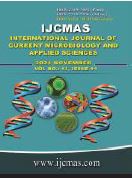


 National Academy of Agricultural Sciences (NAAS)
National Academy of Agricultural Sciences (NAAS)

|
PRINT ISSN : 2319-7692
Online ISSN : 2319-7706 Issues : 12 per year Publisher : Excellent Publishers Email : editorijcmas@gmail.com / submit@ijcmas.com Editor-in-chief: Dr.M.Prakash Index Copernicus ICV 2018: 95.39 NAAS RATING 2020: 5.38 |
Combined Antiretroviral therapy has markedly reduced HIV-related death. The life expectancy of PLHIV is now similar to that of the general population. Psychosocial and socioeconomic supports, best obtained from the family members, is a major determinant of quality of life (QOL) of PLHIV. This study assessed the family functioning of patients attending ART clinic of Irrua Specialist Teaching hospital, Irrua, as a measurement of their accessible family support and their satisfaction with their family. A descriptive cross-sectional study design in which 230 consenting PLHIV attending ART Clinic in ISTH, Edo State, Nigeria were systematically selected. A structured questionnaire for sociodemographic and clinical profiles of participants, Smilkstein’s Family System Apgar Questionnaire, and WHOQOL-HIVBREF was used for data collection. Data were analyzed with IBM SPSS version 20.0. Two hundred and sixteen (93.9%) of the participants had functional family. The QOL of the participants is strongly dependent on their family functioning in all QOL domains, except the spiritual/Religious/Personal belief domain. The family functioning is not affected by Gender, Age, HIV-status of partners, level of education or the WHO clinical stage of the participants. The only factor significantly affecting the family functioning of the participants is their marital status. Participants who are married or cohabiting had better family functioning than others. Healthcare provider in care of PLHIV should mandatorily look into the psychosocial life, especially the family functioning of their clients. The family functioning of these patients determined their QOL and other outcomes. They should be encourage to married or abide in their marriage as those who are married had better family functioning.
Adewuyi B. T. and Adewuyi G. M. Quality of life of people living with HIV and AIDS attending Irrua Specialist Teaching Hospital, Edo State, Nigeria. Afr. J. Clin. Exper. Microbiol. 2023; 24 (1): 32-44 https://dx.doi.org/10.4314/ajcem.v24i1.5
Afolabi B A, Afolabi M O, Olowokere S A. Roles of family dynamics on adherence to highly active antiretroviral therapy among people living with HIV/AIDS at a tertiary hospital in Osogbo, South-west Nigeria; Afr Health Sci. 2013; 13(4):920-926. https://doi.org/10.4314/ahs.v13i4.9
AVERT. Global information and education on HIV and AIDS. History of HIV and AIDs overview. www.avert.org/proffessionals/history-hiv-aids/overview. Accessed 20/12/2016
COPMI Family functioning https://www.copmi.net.au/professionals-organisations/copmi-what-works/evaluating-interventions/parents-carers-families/family-functioning/[accessed Oct 27 2024].
Dai, L. T. and Wang, L. N. (2015) Review of Family Functioning. Open Journal of Social Sciences, 3,134-141. http://dx.doi.org/10.4236/jss.2015.312014
Henry P D. Family Functioning: a cross-cultural appraisal. Bull World Health Organ. 1978; 56(3):327-342.
HIV statistics, globally and by WHO region, 2023. Epidemiological fact sheet. https://cdn.who.int/media/docs/default-source/hq-hiv-hepatitis-and-stis-library/j0294-who-hiv-epi-factsheet-v7.pdf
Jenni M Wise, Andres Azuero, Deborah Konkle-Parker, James L Raper, Karen Heaton, David E Vance et al., Socioeconomic, Psychosocial, and Clinical Factors Associated With Employment in Women With HIV in the United States: A Correlational Study. J Assoc Nurses AIDS Care. 2022 Jan-Feb;33(1):33-44. https://doi.org/10.1097/JNC.0000000000000297.
Marta Sistere-Oro, Naina Andrade, Diana D. J., Wortmann, Natalia Garcia-Giralt, Maria Gonzalez-Cao. Anti-SARS-COV-2 specific immunity in HIV immunological non-responders after mRNA-based COVID-19 vaccination. Brief Research Report article: Front. Immunol., 26 August 2022 Sec. Vaccines and Molecular Therapeutics Volume 13 - 2022 https://doi.org/10.3389/fimmu.2022.994173
Micheala Murphy, Rachel Nall, Ashley Williams. The History of HIV and AIDS in United States. Sexual Health; Healthline. Updated 12th October, 2021. https://www.healthline.com/health/hiv-aids/history Accessed on 25th October, 2024
Motilewa, O. O., Ekanem, U. S., Onayade, A., and Sule, S. S. A comparative study of Health-related Quality of Life among HIV patients on pre-HAART and HAART in Uyo, South-south, Nigeria. J. Antiretrovir. 2015: 7; 60-68. https://doi.org/10.4172/JAA.1000120
National AIDS/STIs control program, Federal ministry of health of Nigeria. Integrated National Guidelines for HIV prevention, treatment and care. 2016: 5-75.
The HIV-CASUSAL Collaboration. The Effect of Combination Antiretroviral on the overall mortality of HIV-infected Individuals. AIDS. 2010 Jan2; 24(1): 123-137. https://doi.org/10.1097/QAD.0B013E3283324283
UNAIDS. Global HIV Statistics. www.unaids.org/sites/default/files/media_asset/UNAIDS_FactSheet_en.pdf
Wang-Da Liu, Wan-Chen Tsai, Wei-Ting Hsu, Ming-Chieh Shih, Mao-Yuan Chen, Hsin-Yun Sun et al., Impact of initiation of combination antiretroviral therapy according to the WHO recommendations on the survival of HIV-positive patients in Taiwan. Journal of Microbiology, Immunology and Infections, Volume 53, Issue 6, December 2020, Pages 936-945. https://doi.org/10.1016/j.jmii.2019.03.008.
WHO. WHOQOL-BREF: Measuring Quality of Life. WHO Tools and Toolkits. https://www.who.int/tools/whoqol Accessed 2022-06-24
Yi-Ching Lynn Ho, Dhiya Mahirah, Clement Zhong-Hao, Julian Thumboo. The role of the family in health promotion: a scoping review of models and mechanisms. Health Promot Int. 2022 Dec 1; 37(6):daac119. https://doi.org/10.1093/heapro/daac119.
 |
 |
 |
 |
 |